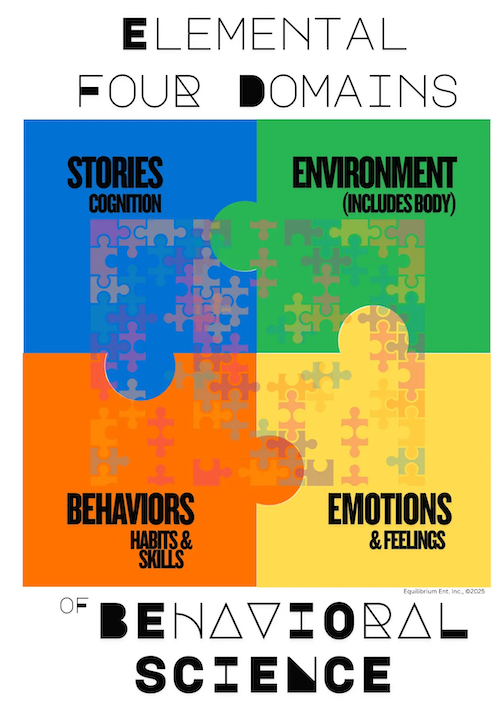Three months, 1,000+ downloads, zero disproof. The Unified Behavior Model challenges anyone to prove it wrong—and if you’re the first, $1,000 is yours.

Open Science: The Unified Behavior Model- an elemental, unified, and falsifiable framework (and, allegedly, the first of its kind).
Grandma always said, “Start with the corners!”
Whether building a puzzle or attempting to build a model of human behavior, Grandma’s advice applies in spades.
For nearly 150 years, behavioral science has been a self-described, incoherent patchwork of scattered models, frameworks, theories, and therapies.
Below is a small sample of articles from the past ten years. Take note of the “Key Sentiments”-and the telling title, “Is It Science?”

Freud here. Skinner there. ACT versus CBT.
Bandura here, Kahneman there.
Each reveal a piece of the puzzle, yet none agree on its frame-its foundation.
(See: 1991 National Institute of Mental Health consortium-an ambitious but ultimately unsuccessful attempt at unification.)
Unification: an ambition, not a threat.

Enter: The Four Corner Foundation
The Unified Behavior Model (UBM) makes an audacious, bold, falsifiable claim:
Every behavior — every action — emerges from the interaction of just four elemental domains.
Not five. Not fifteen. Definitely not forty-nine.
The Unified Behavior Model (UBM) makes an audacious, bold, falsifiable claim:
JUST FOUR ELEMENTAL DOMAINS.
🧩 STORIES (Cognition) — Your mental narratives, beliefs, and meaning-making. The inner monologue that shapes how you see yourself and reality. From CBT to Narrative Therapy, this is where thoughts drive feelings and actions.
🧩 ENVIRONMENT (Includes the Body) — Your physical space, social context, and biology. Behaviorally speaking (that’s key, since this is a behavior model), you are not separate from your environment. Culture, media, and your nervous system all act as behavioral stimuli.
🧩 BEHAVIORS (Habits & Skills) — Observable, shapeable actions. The mechanics of how patterns become automatic through repetition and feedback. Cues trigger responses. Skills develop through practice. Behaviors reinforce themselves and influence one another.
🧩 EMOTIONS (& Feelings) — The affective conduits, the neural pathways that signal and relay. Emotions and feelings are the most variable and ephemeral elements of the system — sometimes the most influential, sometimes the least, depending on context.
The “Behavior Echo-System” (BES)
Here’s what makes UBM totally different: these aren’t just four elemental silos.
Together, they form a unified system — the Behavior Echo-System.

It’s Systems Theory, operationalized.
Your environment influences your behavior, and your behavior, in turn, may influence your environment-echoing dynamically throughout the system and its parts.

Behaviors never occur in a vacuum.
Behaviors may evoke emotions. Emotions, in turn, may influence narratives, which may then feed back-altering or reshaping the environment.
Interdependence. Influence one domain, and reverberations echo throughout the system.
Holism. The Behavior Echo-System transcends the sum of its parts. Behavioral constructs such as discipline and motivation are not elemental; they emerge from the interaction-often the blend-of the core four domains.
Example: Low motivation could stem from the Environment (your body’s low blood sugar), uncertainty about Behavioral skills, or Cognitive Stories like “There’s no way I can do this.” Often, it’s a blend-echoing throughout the system.
Feedback loops. UBM applies the P.A.R.R. protocol (Plan-Act-Record-Reassess), mirroring the scientific method itself. P.A.R.R. gives you the steering wheel for intentional change-allowing you to test, design, and refine behaviors. You input data, attempt new behaviors, record and reassess. (Section 7.0, detail in white paper)
Bidirectional causality. Thoughts may influence feelings driving new behavior. Sometimes an environmental shift; a cold plunge alters your physiology (Environment), rewiring your feelings and story about resilience.
Here’s the key: take away even one elemental corner, and the whole system — the puzzle itself — falls apart.
A Sense of Urgency
Adolescent anxiety, depression, and self-harm have never been higher. See: A Girl and Her Screen (One)
Maps never promise safe arrival-but they cut through confusion.
Maps and models help us see where we are and how to get where we want to go. That’s why people use them every day.
Does behavioral science really need to stay locked in universities, PhD programs, labs, and therapists’ offices?
Where’s the simple, unifying map that says:
Here’s what’s going on. You’re not broken-the system’s just stuck. And here are the four levers you can use to shift it.
Why doesn’t it exist?
Maybe because there was no elemental starting point. And maybe-just maybe-we have that now.
Your Move
Can you find a fifth basic element of behavior — something that is irreducible?
Be the first to find it-something that doesn’t fit within the four corners or emerge from them-and you’ll win an easy $1,000.
If you can’t, share this with someone who loves testing ideas, challenging models, and putting theories to the test.
Invite them to try to break UBM.
Because Grandma was not wrong: start with the corners, and everything falls into place more quickly-and the entire picture becomes clear.
Who’s up for the challenge?
Looking at you, top psych departments-according toU.S. News & World Report, 2025): @StanfordPsych, @HarvardPsych, @UCBPsychology, @UCLPALS, @Psych_at_Yale, @UMichPsych, @UCLA_Psych, @UCSDPsych, @OxfordPsych, @PrincetonPsych.
Please, with all due respect, step right up. 👊 🤙 🙏